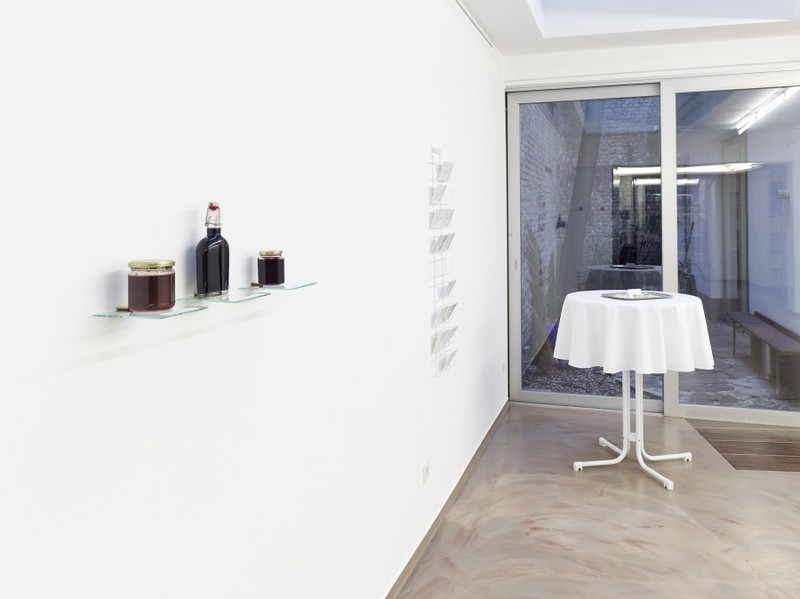Vera Drebusch
17 Jan - 22 Feb 2014
VERA DREBUSCH
Zeitschleife
17 January — 22 February 2014
Vera Drebusch, born in 1986, deals with contemporary history and its ‘updating’ in the form of personal memories and testimonies in her photographic-, textual- and mediaworks. They gain relevance through the encounter of individual lives and hirstorical events, similar to a knot of a ribbon.
By asking people who consciously perceived the nulear reactor accident in Tschernobyl in 1986 about their recollection of, she receives answers like: “Going outside, you are not allowed to open your mouth!”. These satements sensualize the abstract drastical a far away incident and translate it into a concrete experience, that one is able to understand. The statements concerning the body directly (that deal with food and breathing for example) even have the strength to make the understanding almost inevitable. Drebusch makes those experiences present, for example the prohibition to consume certain foods due to their vulnerability to radiation. The pralines she is offering to the gallery visitors at the opening are made of then ‘forbidden’ ingredients. That they are harmless is generally a matter of trust.
Drebusch’s jam and juices made of fruits having grown on grounds of embassies of far away countries in Bonn, aim in a similar physical way (and therefore inevitable) at abstract historically political agreements. In this case at the agreement on political territories. The soil in which the plants grow belongs, according to international law, to the exotic countries of Iran, Iraq and Saudi Arabia (all rich of conflicts), even though the good civic, democratically administered soil of the city of Bonn is only some meters away. The abstract division of territory, based on contracts, is always underlied by the texture of the soil, being ultimately a physical feature of the people living of it.
Her own biography becomes subject of her works in 2013 when Vera Drebusch travels to Bogota for six months and meets same-aged artist Andrés Baron there. Comparing both their family histories up to the generation of their grandparents. They notice remarkable similarities that were used for the artist’s book 9256.122km, in which old family photo albums are intertwined.
During her stay in Bogota, Drebusch came across the radio programme Las voces del secuestro (engl.: voices of abduction) that sends out messages of relatives of abducted people every Sunday night between 12 am and 6 am in the hope that they reach the victims in unknown places. In the installation “Geisel-Radio” (hostage radio), consisting of a marble memorial stone, grained with red veins (Levanto Rosso), and a sound/transmitter-installation, the artist talks about this hostage radio and about how she has come to know of it.
Zeitschleife
17 January — 22 February 2014
Vera Drebusch, born in 1986, deals with contemporary history and its ‘updating’ in the form of personal memories and testimonies in her photographic-, textual- and mediaworks. They gain relevance through the encounter of individual lives and hirstorical events, similar to a knot of a ribbon.
By asking people who consciously perceived the nulear reactor accident in Tschernobyl in 1986 about their recollection of, she receives answers like: “Going outside, you are not allowed to open your mouth!”. These satements sensualize the abstract drastical a far away incident and translate it into a concrete experience, that one is able to understand. The statements concerning the body directly (that deal with food and breathing for example) even have the strength to make the understanding almost inevitable. Drebusch makes those experiences present, for example the prohibition to consume certain foods due to their vulnerability to radiation. The pralines she is offering to the gallery visitors at the opening are made of then ‘forbidden’ ingredients. That they are harmless is generally a matter of trust.
Drebusch’s jam and juices made of fruits having grown on grounds of embassies of far away countries in Bonn, aim in a similar physical way (and therefore inevitable) at abstract historically political agreements. In this case at the agreement on political territories. The soil in which the plants grow belongs, according to international law, to the exotic countries of Iran, Iraq and Saudi Arabia (all rich of conflicts), even though the good civic, democratically administered soil of the city of Bonn is only some meters away. The abstract division of territory, based on contracts, is always underlied by the texture of the soil, being ultimately a physical feature of the people living of it.
Her own biography becomes subject of her works in 2013 when Vera Drebusch travels to Bogota for six months and meets same-aged artist Andrés Baron there. Comparing both their family histories up to the generation of their grandparents. They notice remarkable similarities that were used for the artist’s book 9256.122km, in which old family photo albums are intertwined.
During her stay in Bogota, Drebusch came across the radio programme Las voces del secuestro (engl.: voices of abduction) that sends out messages of relatives of abducted people every Sunday night between 12 am and 6 am in the hope that they reach the victims in unknown places. In the installation “Geisel-Radio” (hostage radio), consisting of a marble memorial stone, grained with red veins (Levanto Rosso), and a sound/transmitter-installation, the artist talks about this hostage radio and about how she has come to know of it.

